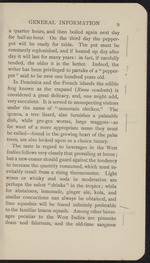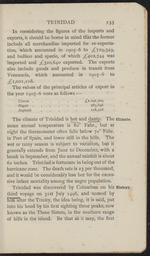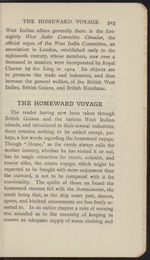| 1 |
 |
“...name of “mountain chicken.” The
iguana, a tree lizard, also furnishes a palatable
dish, while gru-gru worms, large maggots—as
for want of a more appropriate name they must
be called—found in the growing heart of the palm
trees, are also looked upon as a choice luxury.
The taste in regard to beverages in the West
Indies follows very closely that prevailing at home;
but a new-comer should guard against the tendency
to increase the quantity consumed, which must in-
evitably result from a rising thermometer. Light
wines or whisky and soda in moderation are
perhaps the safest “ drinks ” in the tropics; while
for abstainers, lemonade, ginger ale, kola, and
similar concoctions can always be obtained, and
lime squashes will be found infinitely preferable ■
to the familiar lemon squash. Among other bever-
ages peculiar to the West Indies are pimento
dram and falernum, and the old-time sangaree...”
|
|
| 2 |
 |
“...;£729>349>
and bullion and specie, of which ^402,744 was
imported and ^320,640 exported. The exports
also include goods and produce in transit from
Venezuela, which amounted in 1905-6 to
^x,ooi,108.
The values of the principal articles of export in
the year 1905-6 were as follows :—
Cocoa.......................,£1.041,109
Sugar....................... 965 >846
Asphalt . . . . . 118,918
The climate of Trinidad is hot and damp. The Climate,
mean annual temperature is 80° Fahr., but at
night the thermometer often falls below 70° Fahr.
in Port of Spain, and lower still in the hills. The
wet or rainy season is subject to variation, but it
generally extends from June to December, with a
break in September, and the annual rainfall is about
62 inches. Trinidad is fortunate in being out of the
hurricane zone. The death rate is 23 per thousand,
and it would be considerably less but for the exces-
sive infant mortality among the negro population.
Trinidad was discovered by Columbus on his History,
third...”
|
|
| 3 |
 |
“...now the principal commercial
town of the island. It has a magnificent harbour,
which is protected by three forts.
Sugar is the principal industry of Martinique, industries,
and thi7 crop suffered less from the eruptions of
1902 than cocoa, which is mainly grown in the
north of the island. Coffee, indigo, mahogany
and cinnamon also figure among the exports. "
During the months of November, December, Climate.
January, and February the north wind prevails,
and under its cooling influence the thermometer
descends as low as 75° Fahr. in the towns and
66° Fahr. in the higher situations. The east wind
blows from March to June, during which months |
the climate is delightful.
The date of the discovery of Martinique is History,
uncertain, but it is believed that the event took
place in either 1493 or 1502. It was first settled
by France in 1635, but was captured by the
English in 1762, to be restored in the following...”
|
|
| 4 |
 |
“...and west.
industries. In Hayti tobacco and sugar are cultivated,
and the island is supposed to possess valuable
deposits of coal, copper, and other minerals.
Sugar is extensively cultivated in San Domingo,
and tobacco, coffee, bananas, and cocoa are also
exported, together with mahogany, cedar, and
satin woods. No attempt has as yet been made
to develop the deposits of iron, gold, copper,
and salt, which are known to exist in the island.
Climate. The climate of Hayti is hot and moist, the
thermometer in the plains often rising to 96° Fahr.
and sometimes 100° Fahr. Rains are heaviest and
most frequent in May and June, when the rivers
often hood the plains. Hurricanes are not
frequent, but gales often occur.
History. Columbus visited Hayti from Cuba, landing at
Mole St Nicolas on 6th December 1492. He
found the island inhabited by 2,000,000 aborigines,
who called the island Hayti, the “Mountainous
Country,” and Quisquica, the “Vast Country”;
but Columbus changed the name to Espagnola, or...”
|
|
| 5 |
 |
“...cyclone of
1899, has done much to injure this one-time
important industry. Puerto Rico coffee only re-
quires to be better known for it to rank with the
finest produced in the world.
Being but a few degrees within the tropics,
Puerto Rico enjoys exceptionally favourable cli-
matic conditions. The weather is cool in the
winter months, and there is always a marked
difference between the night and day tempera-
tures. From November td March the tempera-
ture rarely rises above 75° Fahr., while the
thermometer often falls as low as 50° Fahr. to
60° Fahr. The lowlands in the north have a
superabundance of rain, but the south is subject
to droughts. Since the occupation of the island
by America, its sanitation has undergone a marked
improvement.
Puerto Rico, “ the Rich Port ” of the Spaniards
and the Borinquen of the aboriginal inhabitants,
was discovered by Columbus in 1493. In 1508
a settlement was founded in the island by Ponce...”
|
|
| 6 |
 |
“...to their several industries,
there remains nothing to be added except, per-
haps, a few words regarding the homeward voyage.
Though “ Home,” as the creole always calls the
mother country, whether he has visited it or not,
has its magic attraction for creole, colonist, and
tourist alike, the return voyage, which might be
expected to be fraught with more enjoyment than
the outward, is not to be compared with it for
conviviality. The spirits of those on board the
homeward steamer fall with the thermometer, the
result being that, as the ship nears port,
sports, and kindred amusements are less freely re-
sorted to. In an earlier chapter a note of warning
was sounded as to the necessity of keeping in
reserve an adequate supply of warm clothing and...”
|
|
